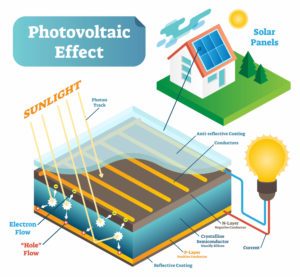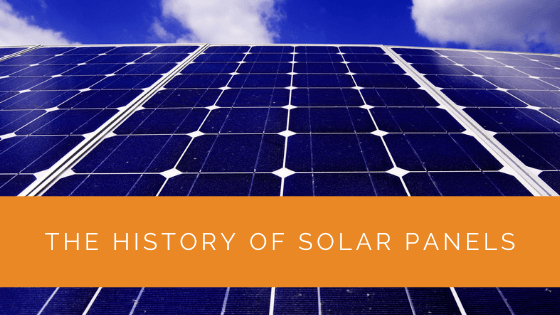Technological developments in clean energy have made some incredible leaps and bounds in the recent past. But surprisingly, the biggest one of them all, the solar panel, traces its roots all the way back to the 1800s.
In the modern world, we celebrate Earth Day on April 22nd every year. However, the efforts that were taken to generate awareness about the environment started long before that.
The creation of the solar panel is a fascinating story woven by physicists and engineers. Continue reading for a brief history lesson on solar panels and how they came to be!
Contents
- 1 Key Takeaways
- 2 Early Discoveries
- 3 What Were the First Observations?
- 4 Awareness of Solar Technology
- 5 When Did Solar Panels Become a Viable Energy Alternative?
- 6 Commercial Adoption Of Solar Panels
- 7 Efficiency And Price Of Solar Panels Through The Years
- 8 How Did Solar Panels Become So Popular?
- 9 Expert Insights From Our Solar Panel Installers About the History of Solar Panels
- 10 Experience Solar Excellence with Us!
- 11 Summing Up
Key Takeaways
- Solar energy technology has a long history dating back to ancient civilizations, with early uses for lighting and heat generation.
- Modern solar panels trace their origins to the 19th century, with the discovery of the photovoltaic effect by Alexandre-Edmond Becquerel and the development of silicon solar cells by Bell Labs in the 1950s.
- Solar panels have become increasingly popular and efficient over the years, with falling costs and rising efficiency, leading to widespread adoption and innovative applications like building-integrated photovoltaics (BIPV) and heat-based electricity generation.
Early Discoveries
It may come as a surprise, but solar energy has been around since the 7th century BC. Attempts were made for amplification of the sun’s rays which would result in a fire.
Later, in the 3rd century BC, Romans and Greeks used to light torches for religious festivals. These torches were known as “burning mirrors.”
In the 2nd century BC, Archimedes discovered the reflective capabilities of brass and used this to set fire to Roman ships that were attacking Syracuse. Much later, in the 6th century AD, sunrooms became a popular part of house construction.
Ancient civilizations were aware of the benefits of solar power and how it was capable of being harnessed for better use. But there was no clear direction, and its use was not geared toward an organized, universal scientific discovery.
What Were the First Observations?
The story of the modern solar panels starts in 1839 with a young French physicist, Alexandre-Edmond Becquerel. He observed and discovered the foundation of the solar panel, the photovoltaic effect.
The photovoltaic effect occurs when radiant energy gets absorbed by a material and further gets transformed into electrical voltage or current.
However, despite significant research and development surrounding this discovery, photovoltaic power was very inefficient. Hence, scientists largely used it to measure light.
Augustin Mouchot, a French mathematician, later took this up and started registering parents in the 1860s for solar energy powered engines.
Almost a decade later, in 1873, Willoughby Smith stumbled upon the discovery that selenium was capable of functioning as a photoconductor.
It was nearly 50 years after discovering the photovoltaic effect that American inventor Charles Fritz took this innovation forward. He created the first fully functioning selenium solar cell.
Although we use silicon in modern solar panels, Fritz’s creation was a major precursor to solar panels’ later development and efficiency.
Many physicists played a significant role in the journey of the solar panel. While Becquerel was responsible for uncovering the photovoltaic effect, Fritz’s credit lies in creating the first prototype of the modern solar panel.

Awareness of Solar Technology
Even though solar power was starting to make progress, it wasn’t until 1905 that more people became aware of it. Albert Einstein published a paper on the photoelectric effect that detailed out how light carried energy.
Einstein’s paper helped generate more interest and awareness in the field, and there was a broader acceptance of solar power.
Bell Labs’ Silicon Cell
The next big step after Becquerel and Fritz came around in 1954. Three scientists at Bell Labs, Daryl Chapin, Calvin Fuller, and Gerald Pearson, created the first silicon solar cell.
The silicon solar cell was much more practical as it was far more efficient and widely available as a natural resource.
Following the creation of the silicon solar cell, solar panels made their entry into space technology. Scientists used them to cover various parts of space crafts throughout the 1950s and 1960s. Vanguard I was the first in 1958, followed by Vanguard II, Explorer III, and Sputnik-3.
NASA launched the Nimbus satellite in 1964, which ran entirely on a 47-watt photovoltaic solar panel array. Solar energy was already making a name for itself in space technology. Soon, it would be a part of homes and businesses on Earth.
When Did Solar Panels Become a Viable Energy Alternative?
Back in the 1970s, a sudden and severe oil shortage threw light on U.S. dependency on foreign energy resources. Issues compounded with high inflation and shortages in essentials. Further innovation and development had become a dire need.
During this time of difficulty, President Jimmy Carter had solar panels installed on the White House roof to spread a tangible message of awareness surrounding the need for clean energy.
This was the first significant step towards incorporating solar panels into our daily lives. Since then, cost and efficiency have been improving, albeit slowly. But the most significant leaps in terms of price, efficiency, and technology have taken place only in recent years.
Commercial Adoption Of Solar Panels
With the discovery of the photovoltaic effect and the photoelectric effect, models and designs based on solar cells started coming up worldwide from various inventors and designers. However, none of them were suitable for commercial use.
The discovery of Bell Labs’ silicon solar cells brought about a change in the industry. The three scientists, Chapin, Fuller, and Pearson, were responsible for the eventual creation of the modern solar panel as we know it today.
This first “practical” solar cell gave a 6 per cent energy conversion rate. Despite this groundbreaking innovation, costs were still extremely high and prevented widescale adoption.
Western Electric made some efforts in 1956 to sell licenses for silicon-based photovoltaic technology, but the skyrocketing costs prevented the growth of this innovation across the entire market.
The United States Congress passed the Solar Energy Research, Development and Demonstration Act of 1974 due to a sudden national emergency crisis. The University of Delaware followed this up with the creation of “Solar One”, one of the world’s first solar buildings.

Efficiency And Price Of Solar Panels Through The Years
Becquerel’s initial discovery was not extremely efficient or cost-effective. Early solar panels brought forth around 1 per cent efficiency and cost $300 per watt. If you were to generate electricity from coal, the price was between $2 and $3. Solar energy was quite unaffordable.
Bell Labs’ silicon solar cells pushed efficiency up to around 4 per cent, which later went up to as much as 11 per cent. For the first time in history, solar energy could power an electric device for several hours with no glitches.
In 1959, Hoffman Electronics achieved 10 per cent efficiency, and within a year by 1960, they pushed this up to 14 per cent efficiency.
Throughout the 1960s, with the increased use of solar panels in space programs due to rising efficiency, costs for local use started coming down. It hit $100 per watt by the mid-1960s, a significant drop from the initial $300.
Prices fell further in the 1970s with Dr Elliot Berman’s research funded by Exxon that produced a less expensive solar cell. This pushed the solar panel cost down to $20 per watt.
Since the 1980s, the costs of solar panels have dropped by around 10 per cent per year on average.
Currently, the average efficiency of solar panels for homes hovers around 15 to 18 per cent, and costs can be as low as $0.50 per watt.
How Did Solar Panels Become So Popular?
The modern popularity of solar panels is largely due to consistently rising efficiency accompanied by falling costs. The National Renewable Energy Laboratory invented a new solar cell in 1994 that achieved a 30 per cent conversion rate.
Residential solar panel integration became a huge part of the market from the early 2000s, and there was a sudden rise in the availability of DIY solar panel kits from 2005 onwards.
Today, solar panel cells are paper-thin and produced primarily through industrial printers. Back in 1883, the idea of converting these cells into roof tiles or shingles was only a distant dream. But this is how far we have come today in terms of solar panel development.
Installation costs have fallen by nearly 70 per cent within the last ten years. A single strip can produce around 50 watts of solar energy per square meter. Companies are now focusing on the aesthetics and design functionality of solar panels.
For example, building applied photovoltaic panels (BAPV) are discreet and integrate directly into existing roof tiles. They can also integrate into ceramic or glass structures.
The most recent development in solar panel technology occurred when a research team discovered some new nanomaterial properties. The most important of these was magnetic hyperbolic dispersion.
This innovation can generate electricity purely from heat, even in the complete absence of sunlight.
Expert Insights From Our Solar Panel Installers About the History of Solar Panels
The journey of solar panels is a testament to human ingenuity and our drive for sustainable solutions. From the early photovoltaic discoveries to today’s highly efficient silicon cells, the progress has been remarkable.
Senior Solar Installer
Understanding the history of solar panels helps us appreciate the technological advancements that make today’s solar energy solutions possible. It’s fascinating to see how far we’ve come from the first selenium cells to modern-day applications.
Solar Energy Technician
The evolution of solar panel efficiency and affordability has made solar energy accessible to more people than ever before. It’s exciting to be part of an industry that’s making such a positive impact on the environment.
Solar Maintenance Specialist
Experience Solar Excellence with Us!
Trust in Solar Panels Network USA, where our seasoned experts deliver top-quality solar solutions for homes and businesses nationwide. With a legacy of countless successful installations and a commitment to sustainable energy, we’re your reliable partner in the solar journey. Ready for a brighter, eco-friendly future? Call us now at (855) 427-0058 and harness the power of the sun!
Summing Up
The history of solar panels and solar energy technology shows that scientists are still searching for the best means to harness sunlight in a cost-effective and highly efficient manner.
We have come a long way from 1839 when Alexandre-Edmond Becquerel discovered the photovoltaic effect. However, there is still plenty of room to grow.
With new promising innovations coming up from companies such as Tesla, solar panels and solar energy technology in the modern era has only just begun its journey. There is plenty to look forward to in the future of solar panels!
About the Author
Solar Panels Network USA stands at the forefront of solar energy solutions, driven by a team of seasoned solar engineers and energy consultants. With over decades of experience in delivering high-quality solar installations and maintenance, we are committed to promoting sustainable energy through customer-centric, tailored solutions. Our articles reflect this commitment, crafted collaboratively by experts to provide accurate, up-to-date insights into solar technology, ensuring our readers are well-informed and empowered in their solar energy decisions.

